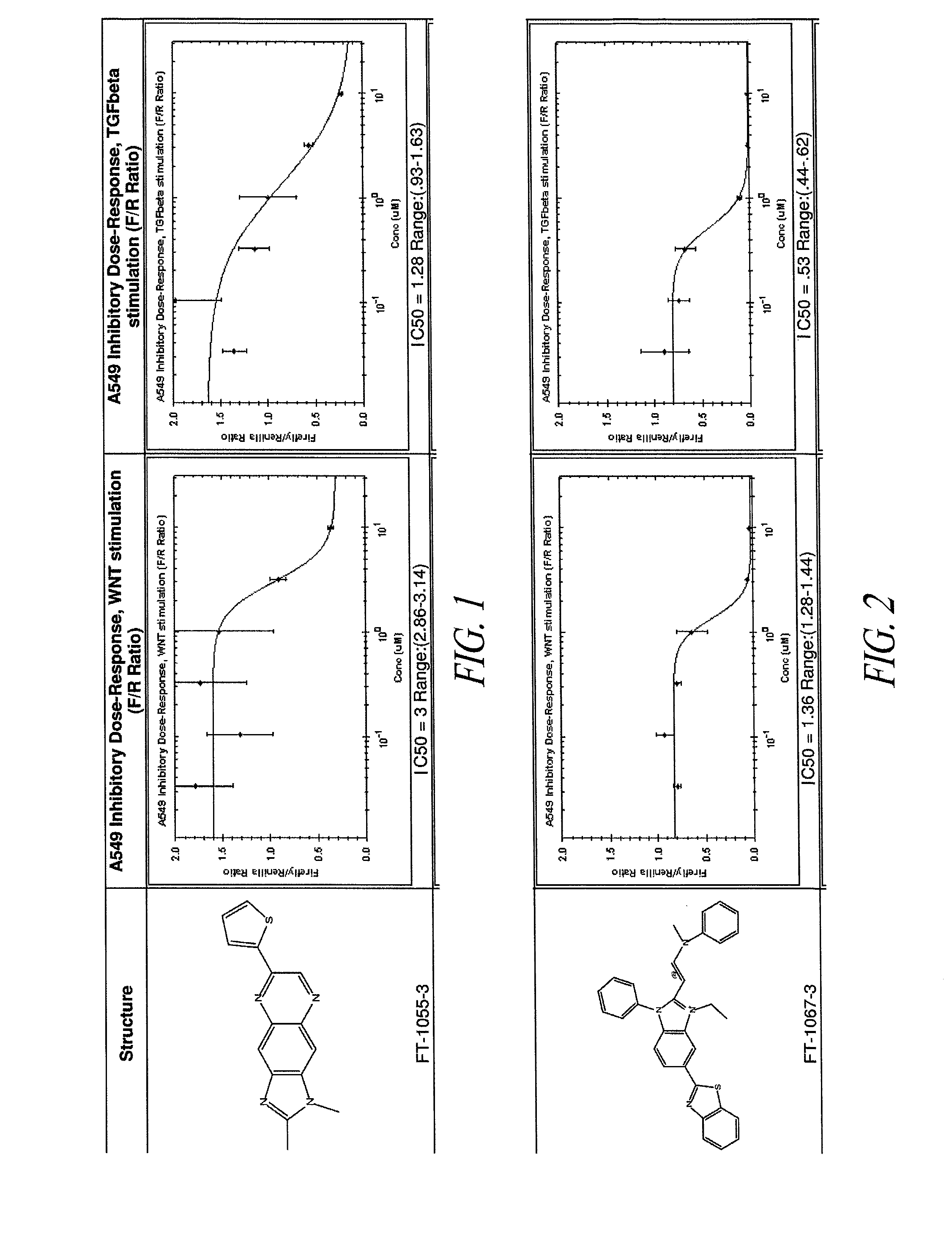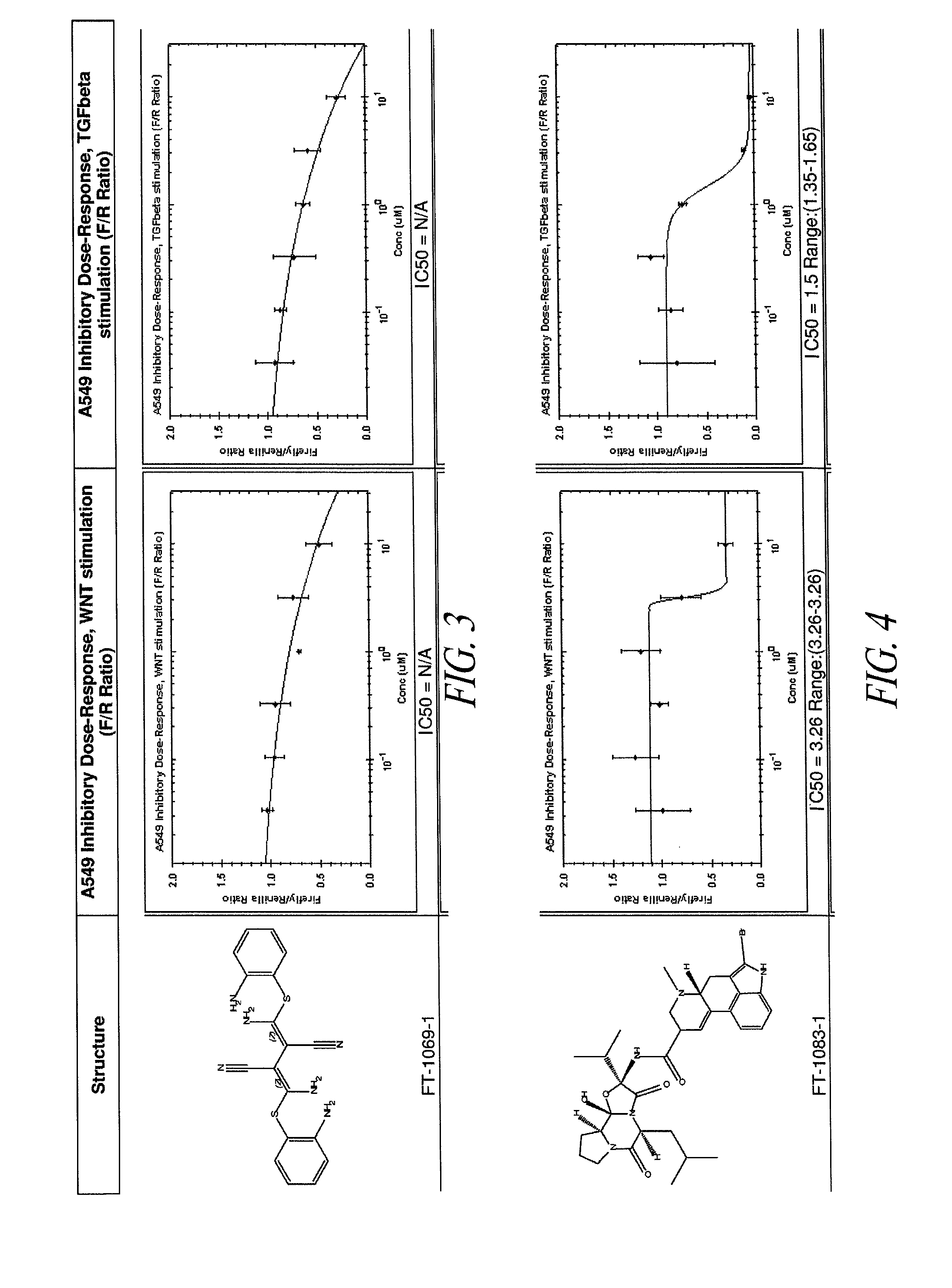Pharmaceutical compositions to treat fibrosis
a technology of fibrosis and compositions, applied in the direction of drug compositions, biocides, immunodeficiency disorders, etc., can solve the problems of ckd, inability to cure, and inability to prevent ckd, so as to prevent or reduce fibrosis
- Summary
- Abstract
- Description
- Claims
- Application Information
AI Technical Summary
Benefits of technology
Problems solved by technology
Method used
Image
Examples
example 1
Identification of Wnt- and TGF-b-Mediated b-Catenin Signaling Antagonists in a Human Lung Epithelial Cell Line
[0292]A human lung epithelial cell line (A549; obtained from ATCC) was stably infected with a lentiviral β-catenin reporter construct (pBARL), to allow β-catenin signaling to be measured. β-catenin is known to regulate transcription in combination with TCF and LEF transcription factors. Accordingly, the 6-catenin report construct included a multimerized motif of 12 TCF / LEF DNA binding sites as a transcriptional control element to drive firefly luciferase expression. A549 cells were stably transduced with the lentiviral β-catenin reporter and with a Renilla luciferase construct comprising a constitutive promoter. The constitutive expression of Renilla luciferase served as a normalization tool for the firefly luciferase activity measurements. The resultant cell line was referred to as A549 / pBARL.
[0293]A library of small molecule compounds was screened to identify those compoun...
example 2
Wnt- and TGF-b-Mediated b-Catenin Signaling Antagonists Inhibit TGF-b Mediated Emt in Mouse Type II Alveolar Cells
[0297]Mouse type II alveolar cells (ATII) were isolated from adult mice (6-12 weeks old) as described by Corti et al., Am J Respir Cell Mol Biol. 1996; 14, 309-315. ATII cells were cultured on fibronectin-coated tissue culture plates in SAGM medium (Lonza) containing 5% charcoal-treated fetal bovine serum+10 ng / mL KGF and either a 1:2000 dilution of DMSO (a negative control), 5 uM FT-2097, 5 uM FT-3934, 5 uM FT-4001 or 5 uM SB431542 (a positive control that inhibits TGF-β signaling). ATII cells cultured on fibronectin induced EMT by stimulating a TGF-β autocrine / paracrine loop. ATII cells were retreated after two days and cultured for an additional 3 days, which provided 5 days of total treatment.
[0298]Inhibition of EMT by treated with DMSO (a negative control), 5 uM FT-2097, 5 uM FT-3934, 5 uM FT-4001 and 5 uM SB431542 was determined by analyzing the amount of the EMT m...
PUM
| Property | Measurement | Unit |
|---|---|---|
| Energy | aaaaa | aaaaa |
| Energy | aaaaa | aaaaa |
Abstract
Description
Claims
Application Information
 Login to View More
Login to View More - R&D
- Intellectual Property
- Life Sciences
- Materials
- Tech Scout
- Unparalleled Data Quality
- Higher Quality Content
- 60% Fewer Hallucinations
Browse by: Latest US Patents, China's latest patents, Technical Efficacy Thesaurus, Application Domain, Technology Topic, Popular Technical Reports.
© 2025 PatSnap. All rights reserved.Legal|Privacy policy|Modern Slavery Act Transparency Statement|Sitemap|About US| Contact US: help@patsnap.com



